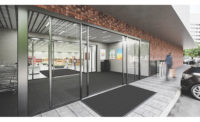Part of this attraction might indeed come from nature. Think about the similarities between our human construction activities and those of other social and communal mammals and insects. What might initially appear to be chaotic comings and goings of prairie dogs, birds, bees, and ants turns out to be the necessary ingredients for constructing elaborate systems of travel, storage, breeding, living, and sleeping spaces. Whether driven by innate biological impulses to produce honey or blueprints to produce a 100-story skyscraper, the process is the same: a series individual tasks add up to infrastructure, shelter, and the satisfaction of need.
But there’s one difference, and it has to do with safety. Nature has outfitted mammals and insects with “personal protection” that unfortunately is not standard equipment for us. We’re not naturally equipped to counter gravity, carry more than 100 times our own weight, protect our eyes and lungs from dust and dirt, or slow our breathing to a point where we could survive an earthen collapse.
Our sophisticated brains and ability to analyze and reason can make us feel superior to those we share the habit of construction with. But if that were really true, and humans were superior, wouldn’t you think that the number of occupational injuries and illnesses on construction sites would be near zero?
Nature’s way
I’m not proposing that insects are superior to humans (at least not all humans) or that insects even think about safety or consequences during their construction activities. But we can take a lesson in safe construction from these “lesser” creatures.So, having laid the foundation (in keeping with the construction theme) and established that I’m not trying to be insanely bug-friendly, let’s examine the differences between safe construction and construction safety by first exploring these phrases.
Construction safety can be active or passive. It’s active when it represents a prime consideration during the design and planning stages of a project, as well as throughout the physical acts of site preparation, demolition, excavation, forming, framing, erection, enclosing, and finishing. The term is passive when it comes to the forefront only after a collapse, injury, or fatality.
Safe construction is an active term, there is nothing passive about it. It is a part of every meeting, drawing, hammer blow, and shovel full of earth. More importantly, safe construction is a part of every individual connected with the project.
Unfortunately, safe construction is not instinctual in humans. For bees, it’s an innate biological predisposition. For us, it must be cultured, stroked, cajoled, managed, and maintained. That’s because money is the main driver behind any human construction project, not an internalized system of caste positions made up of drones, soldiers, and caregivers working together for the ultimate goal of the colony, as in the insect world. (Although we do have laborers, medical staff, and security.)
Market demands and interest rates are fickle, and construction phases and raw material fabrication schedules are time-sensitive to high degrees. So we have to appreciate the fact that anything that slows the construction process — especially a safety initiative that is introduced after the start of the project — is not going to send warm fuzzies through the bosses.
“Time is money,” that age-old adage, refers to an inversely proportionate relationship: less time spent on a project equals more money in the hands of investors. The faster you build it, the sooner you can occupy or sell it. And the sooner you can do that, the less interest owed before the note is paid off. Less interest results in more profits to investors, which means there are smiles all around and you get to keep your job.
If we cut the opposite to the quick, more time equals less money (the roots of this adage are traced to hieroglyphics found in the tomb of the “Smiling Pyramid Builder,” whose unsuccessful predecessor’s tomb is wedged between two very large cut stones).
Solid foundation
Time and money pressures can lead to the consequences of passive construction safety that we see in newspapers and newscasts — trenching cave-ins, scaffolding collapses, overturned cranes, and so on. We’re all familiar with these misfortunes. So instead, I’ll provide an example of an effort toward safe construction.At my place of employment, our present facility houses train controls, train vehicles, electronics maintenance, administration, storage, testing, and shop tracks. Thanks to a $3.2-billion airport expansion project, this facility must be relocated. The project, which includes a new international arrivals/departure terminal, expanded immigration and customs capabilities, streamlined land vehicle flow patterns, and airline/airfield support improvements (Illinois Republicans take note: not a mention of additional runways), will be coordinated over a ten-year period.
Recognizing that this type of project could expose 70,000+ airport employees, tens of millions of airline passengers, and many, many vehicle drivers to construction hazards, we’ve started a training initiative. In partnership with OSHA (yes, the feds can be a valuable resource) this safe construction training initiative will present the OSHA 30-Hour and Construction Outreach Instructor courses to our Department of Aviation, ancillary support, and construction contractor employees.
What better way to begin such a massive project than to provide people with a solid base of knowledge designed to assist with controlling exposures, developing hazards recognition, and showing a commitment to safe construction from the start? This doesn’t guarantee that the decade-long project will go off without a hitch, but it does demonstrate that we have attempted to set a definite path toward successful safe construction and a start toward active construction safety.
Sidebar: Get proactive
- Show a commitment to safe construction before the first shovel full of earth is dug.
- Make safety a prime consideration during the design and planning stages of a project.
- Integrate safety awareness and practices throughout the physical acts of site preparation, demolition, excavation, forming, framing, erection, enclosing, and finishing.
- Make safety issues part of every meeting.
- Give employees and contractors a solid base of knowledge in recognizing and controlling exposures and hazards.
- Safe construction must be a habit of every individual connected with the project.
Sidebar: Perpetuating the myth
A continuing disservice to the professionals involved in the construction trades has recently appeared on television. Presented in the form of a commercial for “Hard Lemonade,” a steel worker (supposedly; the ad agency couldn’t even get the right type of hardhat on the actor) falls from a girder onto a tangled heap of re-bar. Upon picking himself up and dusting off his clothes, he notes an eight-foot length of re-bar extending through his chest, front-to-back.A co-worker approaches and sarcastically notes, “Looks like you’ve got a nick there.” This exchange goes from denial (“I’ll be OK”) to concern (“Maybe you better get that checked”) to what everyone knows construction workers are most concerned about (“Or we could go get a Hard Lemonade”). Cut to the tavern where the re-bar, still imbedded in the worker, is used as a bottle opener.
So there you have it. Advertising encouraging the widely accepted idea that injuries are funny, and that construction workers are more concerned with alcohol than their well-being. Catering to this culture that worships wrestling and daytime scandal talk shows, and making money off of ignorance, is a sad commentary on the state of our society. And it ultimately makes our jobs in safety that much more difficult.




